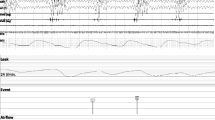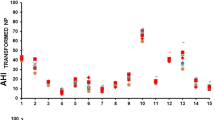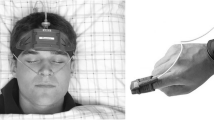Abstract
Background
ApneaLink is a novel single-channel screening device for sleep apnea detection which is based on pressure-transduced measurement of oronasal airflow, summarised as respiratory disturbance index per hour of recording time (RDIApneaLink). We tested ApneaLink's diagnostic performance in a patient population with high prevalence of sleep apnea.
Methods
ApneaLink was applied simultaneously with in-laboratory polysomnography (PSG) (n = 102, 24 female, age 54.7 years) and sequentially with PSG in the unattended home setting (n = 131, 37 female, age 59.1 years). Predictive values were computed for apnea-defining thresholds of apnea–hypopnea index (AHI) ≥ 5/h, ≥10/h, ≥15/h. Night-to-night variability (NNV) was assessed over three consecutive nights (n = 55, 10 female, age 48.9 years).
Results
RDIApneaLink correlated well with apnea–hypopnea index on PSG (PSGAHI) on simultaneous (r = 0.98, bias −0.7) and unattended home application (r = 0.95, bias −0.6). Predictive values were highest at AHI ≥ 10/h (in-laboratory: sensitivity 91.1%, specificity 87.5%, LR+ (positive likelihood ratio) 7.4, LR− 0.1; home: sensitivity 80%, specificity 85.5%, LR+5.5, LR− 0.2). NNV was low \( \left( {V = 0.58 \pm 0.44,{\text{range}}\,0 - 1.69} \right) \).
Conclusion
ApneaLink is an accurate screening tool for sleep apnea in a population with high prevalence of the disorder.



Similar content being viewed by others
References
Young T, Palta M, Dempsey J et al (1993) The occurrence of sleep-disordered breathing among middle-aged adults. N Engl J Med 328:1230–1235
Gottlieb DJ, Whitney CW, Bonckat WH et al (1999) Relation of sleepiness to respiratory disturbance index: the Sleep Heart Health Study. Am J Respir Crit Care Med 159:502–507
Robinson GV, Stradling JR, Davies JR (2004) Sleep 6: obstructive sleep apnea/hypopnea syndrome and hypertension. Thorax 59:1989–1994
Peppard PE, Young T, Palta M, Skatrud J (2000) Prospective study of the association between sleep-disordered breathing and hypertension. N Engl J Med 342:3378–3384
Shahar E, Whitney CW, Redline S et al (2001) Sleep disordered breathing and cardiovascular disease: cross-sectional results of the Sleep Heart Health Study. Am J Respir Crit Care Med 163:19–25
Hamilton GS, Solin P, Naughton MT (2004) Obstructive sleep apnea and cardiovascular disease. Intern Med J 34:420–426
Bassetti C, Aldrich MS (1999) Sleep apnea in acute cerebrovascular diseases: final report on 128 patients. Sleep 22:217–223
Javaheri S, Parker TJ, Liming JD, Corbett WS, Nishiyama H, Wexler L, Roselle GA (1998) Sleep apnea in 81 ambulatory male patients with stable heart failure. Circulation 97:2154–2159
Ellen RL, Marshall SC, Palayew M, Molnar FJ, Wilson KG, Man-Son-Hin M (2006) Systematic review of motor vehicle crash risk in persons with sleep apnea. J Clin Sleep Med 2:193–200
Phillipson EA (1993) Sleep apnea—a major public health problem. N Engl J Med 328:1271–1273
American Sleep Disorders Association Report (1997) Standards of Practice Committee. Practice parameters for the indications for polysomnography and related procedures. Sleep 20:406–422
Young T, Evans L, Finn L et al (1997) Estimation of the clinically diagnosed portion of sleep apnea syndrome in middle-aged men and women. Sleep 20:705–706
Flemons WW, Littner MR, Rowley JA, Gay P et al (2003) Home diagnosis of sleep apnea: a systematic review of the literature: an evidence review cosponsored by the American Acacademy of Sleep Medicine, the American College of Chest Physicians, and the American Thoracic Society. Chest 124:1543–1579
Redline S, Tosteson T, Boucher MA et al (1991) Measurement of sleep-related breathing disturbances in epidemiologic studies: assessment of the validity and reproducibility of a portable monitoring device. Chest 100:1281–1286
Verse T, Pirsig W, Junge-Hulsing B et al (2000) Validation of the POLY-MESAM seven-channel ambulatory recording unit. Chest 117:1613–1618
White D, Gibb T, Wall J et al (1995) Assessment of accuracy and analysis time of a novel device to monitor sleep and breathing in the home. Sleep 18:115–126
Kiely J, Delahunty C, Matthews S et al (1996) Comparison if a limited computerized diagnostic system (ResCare AutosetTM) with polysomnography in the diagnosis of obstructive sleep apnea syndrome. Eur Respir J 9:2360–2364
Wang Y, Weinreich G, Hess S, Wessendorf TE, Teschler H (2003) Validation of MicroMesam as screening device for sleep disordered breathing. Pneumologie 57:734–740
Erman MK, Stewart D, Einhorn D, Gordon N, Casal E (2007) Validation of the ApneaLink™ for the screening of sleep apnea: a novel and simple single-channel recording device. JCSM 3(4):387–392
Rechtschaffen A, Kales AA (1998) Manual of standardized terminology, techniques, and scoring system for the sleep stages of human subjects. Los Angeles Brain Information Service. Brain Research Institute, University of California at Los Angeles, Los Angeles
Sleep-related breathing disorders in adults: recommendations for syndrome definition and measurement techniques in clinical research. The report of an American Academy of Sleep Task Force. Sleep 1999;22:667-89
Farre R, Rigau J, Montserrat JM et al (2001) Relevance of linearizing nasal prongs for assessing hypopneas and flow limitation during sleep. Am J Respir Crit Care Med 163:494–497
Bittencourt LR, Suchecki D, Tufik S, Peres C, Togeiro SM, Bagnato MC, Nery LE (2001) The variability of the apnoea–hypopnoea index. J Sleep Res 10:245–251
Wittig RM, Romaker A, Zorick FJ, Roehrs TA, Conway WA, Roth T (1984) Night-to-night consistency of apneas during sleep. Am Rev Respir Dis 129:244–246
Dingli K, Coleman EL, Vennelle M, Finch SP, Wraith PK, Mackay TW, Douglas NJ (2003) Evaluation of portable device for diagnosing the sleep apnea/hypnopnea syndrome. Eur Respir J 21:253–259
Esnaola S, Duran J, Infante-Rivard C et al (1996) Diagnostic accuracy of a portable recording device (MESAM IV) in suspected obstructive sleep apnea. Eur Respir J 9:2597–2605
Baltzan M, Verschelden P, Al-Jahdali H et al (2000) Accuracy of oximetry with thermistor (OxiFlow) for diagnosis of obstructive sleep apnea and hypopnea. Sleep 23:61–69
Portier F, Portman A, Czernichiv P et al (2000) Evaluation of home versus laboratory polysomnography in the diagnosis of sleep apnea syndrome. Am J Respir Crit Care Med 162:814–818
Mykytin IJ, Sajkov D, Neill AM et al (1990) Portable computerized ploysomnography in attended and unattended settings. Chest 115:114–122
Author information
Authors and Affiliations
Corresponding author
Rights and permissions
About this article
Cite this article
Ragette, R., Wang, Y., Weinreich, G. et al. Diagnostic performance of single airflow channel recording (ApneaLink) in home diagnosis of sleep apnea. Sleep Breath 14, 109–114 (2010). https://doi.org/10.1007/s11325-009-0290-2
Received:
Accepted:
Published:
Issue Date:
DOI: https://doi.org/10.1007/s11325-009-0290-2




